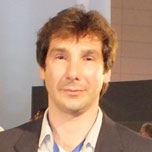Wednesday, 11 August 2021
All times are CEST
Pilot project presentations: City Hearing Log
Speakers meeting link: https://bit.ly/36uVRwF | Meeting attendants: Facebook live at https://www.facebook.com/designscapesproject/
- 17:30-17:45 Welcome and introduction
(Francesco Molinari, ANCI Toscana) - 17:45-18:15 Presentation of the pilot project
(S.Tamascelli, X-Team) - 18:15-18:30 Q&A and Discussion (*)
- 18:30 End
(*) Other winners of the Designscapes call with similar thematic orientation will be invited to contribute
Our speakers

Francesco Molinari is an international researcher and policy advisor with a 20-years working experience in R&D and innovation projects and programmes at European, national and regional levels – notably on such topics as eParticipation, eGovernment and Smart Cities. Formerly he has been engaged for about 12 years in territorial marketing and the delivery of financial services to SMEs – including support to EU grants access for their green and brown field investments. For 5 years he has served in a top managerial position at a middle-sized Municipality in Italy. He holds a track record of successful collaborations with local/regional authorities and ministries on such topics as Pre-Commercial Public Procurement, Living Labs and Smart Specialisation.

Stefano Tamascelli: graduated in Computer Engineering University of Padua, is a senior developer, with experience in project development, Task Leader and Work Package Leader in research and innovation projects funded in the European Horizon 2020 programme, mainly in technical, research and development and innovation activities. Stefano Tamascelli is a partner and founder of XTeam Software Solutions, he is in charge of Research & Development, with over 20 years of experience in developing and designing innovative solutions. With XTeam he has worked on more than 100 commercial projects with partners such as Microsoft, Sony, Samsung, Nintendo, IBM.
Noise pollution is cited as a major factor that reduces the quality of life, especially in large urban areas. European Environmental Agency highlights the danger of noise pollution for the health and well-being of a person. Around 70 million people are exposed to noise levels higher than the Environmental Noise Directive but many studies suggest that the effects on human health appear also where sound levels are below recommended limits.
City Hearing Log is addressed mainly to hearing-impaired people, who are the most disadvantaged by environmental pollution. The project consists of a mobile application that allows users to record sound samples of specific locations and to plot them in an interactive map, continuously updated with all other users’ recordings. Hearing-impaired people will use the app to record the sound conditions of areas they usually cross during everyday life; they will also connect the sound samples with the issues related to their hearing problems. Finally, they can decide to share their data with the audiologist. The geolocated data of noise pollution will be freely accessible on the map also by a dedicated website, where all the city inhabitants can check the sound rating in various locations and decide where to spend their time according to the sound levels they will be comfortable with.
Thanks to the app, the audiologist will easily calibrate the hearing aid devices of the patients exploiting the enormous amount of data while considering the specific challenges of the patient in every sound condition. Moreover, the audiologist can gather the noise history of a specific area and daytime, along with the dB sound level, accelerometer and gyroscopic info. The great anonymous amount of data gathered through the app, along with the map will be available for the city administrators so as to support all the mitigation actions against the noise pollution, both at a policy and governmental level.
Thanks to funding received by DESIGNSCAPES, we have developed the prototype app (now available on Google Play) and carried out extensive tests. We run a series of webinars, workshops, surveys and participatory design sessions to present the app to a number of stakeholders and get feedback. Thanks to the feedback we received, we have implemented and improved the app, such as, for example, introducing the sound samples of other citizens in addition to the user, improving the usability of the app, introducing gamification mechanisms to encourage the user to make many recordings.
In this phase, we have deepened the knowledge of the design tools, increased and recalibrated the business model and got in touch with different stakeholders, professionals, companies and people with hearing problems, who may be interested in the project itself and who have given valuable support to our team in designing and improving the app.
